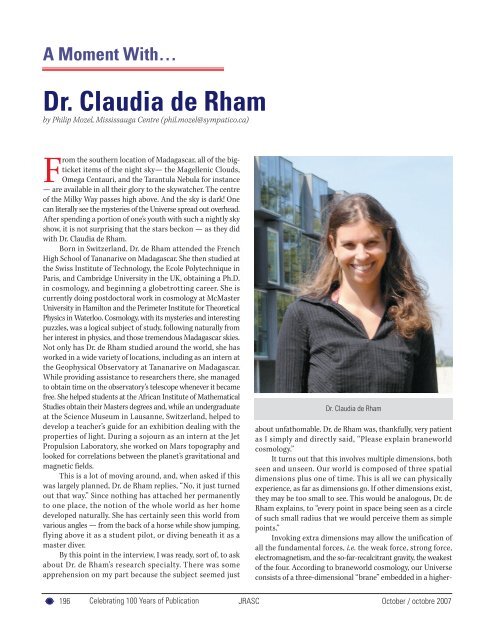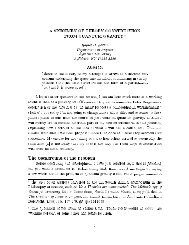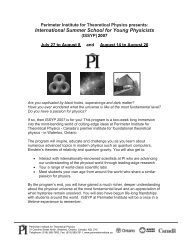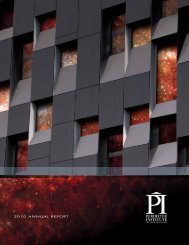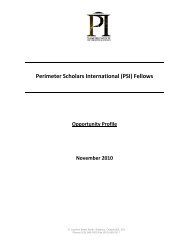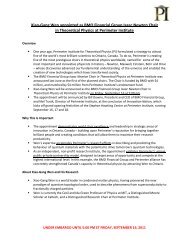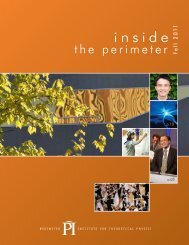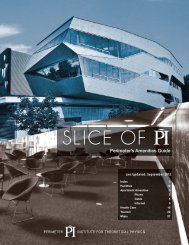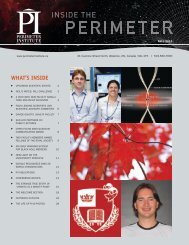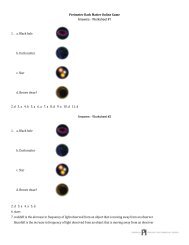Dr. Claudia de Rham - McMaster Physics and Astronomy
Dr. Claudia de Rham - McMaster Physics and Astronomy
Dr. Claudia de Rham - McMaster Physics and Astronomy
You also want an ePaper? Increase the reach of your titles
YUMPU automatically turns print PDFs into web optimized ePapers that Google loves.
A Moment With…<br />
<strong>Dr</strong>. <strong>Claudia</strong> <strong>de</strong> <strong>Rham</strong><br />
by Philip Mozel, Mississauga Centre (phil.mozel@sympatico.ca)<br />
From the southern location of Madagascar, all of the bigticket<br />
items of the night sky— the Magellenic Clouds,<br />
Omega Centauri, <strong>and</strong> the Tarantula Nebula for instance<br />
— are available in all their glory to the skywatcher. The centre<br />
of the Milky Way passes high above. And the sky is dark! One<br />
can literally see the mysteries of the Universe spread out overhead.<br />
After spending a portion of one’s youth with such a nightly sky<br />
show, it is not surprising that the stars beckon — as they did<br />
with <strong>Dr</strong>. <strong>Claudia</strong> <strong>de</strong> <strong>Rham</strong>.<br />
Born in Switzerl<strong>and</strong>, <strong>Dr</strong>. <strong>de</strong> <strong>Rham</strong> atten<strong>de</strong>d the French<br />
High School of Tananarive on Madagascar. She then studied at<br />
the Swiss Institute of Technology, the Ecole Polytechnique in<br />
Paris, <strong>and</strong> Cambridge University in the UK, obtaining a Ph.D.<br />
in cosmology, <strong>and</strong> beginning a globetrotting career. She is<br />
currently doing postdoctoral work in cosmology at <strong>McMaster</strong><br />
University in Hamilton <strong>and</strong> the Perimeter Institute for Theoretical<br />
<strong>Physics</strong> in Waterloo. Cosmology, with its mysteries <strong>and</strong> interesting<br />
puzzles, was a logical subject of study, following naturally from<br />
her interest in physics, <strong>and</strong> those tremendous Madagascar skies.<br />
Not only has <strong>Dr</strong>. <strong>de</strong> <strong>Rham</strong> studied around the world, she has<br />
worked in a wi<strong>de</strong> variety of locations, including as an intern at<br />
the Geophysical Observatory at Tananarive on Madagascar.<br />
While providing assistance to researchers there, she managed<br />
to obtain time on the observatory’s telescope whenever it became<br />
free. She helped stu<strong>de</strong>nts at the African Institute of Mathematical<br />
Studies obtain their Masters <strong>de</strong>grees <strong>and</strong>, while an un<strong>de</strong>rgraduate<br />
at the Science Museum in Lausanne, Switzerl<strong>and</strong>, helped to<br />
<strong>de</strong>velop a teacher’s gui<strong>de</strong> for an exhibition <strong>de</strong>aling with the<br />
properties of light. During a sojourn as an intern at the Jet<br />
Propulsion Laboratory, she worked on Mars topography <strong>and</strong><br />
looked for correlations between the planet’s gravitational <strong>and</strong><br />
magnetic fields.<br />
This is a lot of moving around, <strong>and</strong>, when asked if this<br />
was largely planned, <strong>Dr</strong>. <strong>de</strong> <strong>Rham</strong> replies, “No, it just turned<br />
out that way.” Since nothing has attached her permanently<br />
to one place, the notion of the whole world as her home<br />
<strong>de</strong>veloped naturally. She has certainly seen this world from<br />
various angles — from the back of a horse while show jumping,<br />
flying above it as a stu<strong>de</strong>nt pilot, or diving beneath it as a<br />
master diver.<br />
By this point in the interview, I was ready, sort of, to ask<br />
about <strong>Dr</strong>. <strong>de</strong> <strong>Rham</strong>’s research specialty. There was some<br />
apprehension on my part because the subject seemed just<br />
<strong>Dr</strong>. <strong>Claudia</strong> <strong>de</strong> <strong>Rham</strong><br />
about unfathomable. <strong>Dr</strong>. <strong>de</strong> <strong>Rham</strong> was, thankfully, very patient<br />
as I simply <strong>and</strong> directly said, “Please explain braneworld<br />
cosmology.”<br />
It turns out that this involves multiple dimensions, both<br />
seen <strong>and</strong> unseen. Our world is composed of three spatial<br />
dimensions plus one of time. This is all we can physically<br />
experience, as far as dimensions go. If other dimensions exist,<br />
they may be too small to see. This would be analogous, <strong>Dr</strong>. <strong>de</strong><br />
<strong>Rham</strong> explains, to “every point in space being seen as a circle<br />
of such small radius that we would perceive them as simple<br />
points.”<br />
Invoking extra dimensions may allow the unification of<br />
all the fundamental forces, i.e. the weak force, strong force,<br />
electromagnetism, <strong>and</strong> the so-far-recalcitrant gravity, the weakest<br />
of the four. According to braneworld cosmology, our Universe<br />
consists of a three-dimensional “brane” embed<strong>de</strong>d in a higher-<br />
196 Celebrating 100 Years of Publication<br />
JRASC October / octobre 2007
dimensional space-time called the “bulk.” The Big Bang, for<br />
example, could be explained as the collision between two branes.<br />
The weakness of gravity, propagating as gravitons, is explained<br />
as due to gravitons leaking out along the extra dimensions <strong>and</strong><br />
being diluted in the process. None of the other forces can make<br />
the crossing. <strong>Dr</strong>. <strong>de</strong> <strong>Rham</strong> likens living on a brane to living on<br />
the surface of a body of water, which we can easily see, while a<br />
vast ocean beneath remains un<strong>de</strong>tected.<br />
Now, if gravitons can wan<strong>de</strong>r from one brane to another,<br />
are other dimensions, other universes, <strong>de</strong>tectable? <strong>Dr</strong>. <strong>de</strong> <strong>Rham</strong><br />
points out that, in principle, it is possible to discover other<br />
dimensions. But, keeping in mind that not all braneworld<br />
cosmologies invoke multiple branes, finding one with another<br />
universe would be much more problematic. The graviton effect<br />
would be subtle since we have not yet <strong>de</strong>tected other dimensions<br />
or branes. Of course, <strong>Dr</strong>. <strong>de</strong> <strong>Rham</strong> finds the possibility of such<br />
<strong>de</strong>tection very exciting!<br />
What might such observations be? <strong>Dr</strong>. <strong>de</strong> <strong>Rham</strong> says we<br />
start by asking, “What would be different if we lived on a brane?”<br />
Well, it turns out that Newton’s laws would be different — at<br />
least on scales that have so far gone untested. For example, no<br />
one has looked at the gravitational force over distances of less<br />
than a micron, <strong>and</strong> for good reason. The required measurement<br />
accuracy is of such a high or<strong>de</strong>r that the experiment has been<br />
ren<strong>de</strong>red impractical, at least for now. While testing gravity<br />
over various distances is the best way to check the theory, further<br />
investigations could be done by closely scrutinizing the expansion<br />
of the Universe or un<strong>de</strong>rst<strong>and</strong>ing the nature of dark matter <strong>and</strong><br />
dark energy. One could also look for clues in the cosmic background<br />
radiation in ways similar to what has been done by the Cosmic<br />
Background Explorer satellite (COBE) <strong>and</strong> the Wilkinson Microwave<br />
Anisotropy Probe (WMAP), or will be attempted by the upcoming<br />
Planck mission. The goals of the latter inclu<strong>de</strong> <strong>de</strong>termining the<br />
geometry, contents, origin, <strong>and</strong> evolution of the Universe.<br />
Observations of the microwave background will be ma<strong>de</strong> with<br />
unprece<strong>de</strong>nted accuracy <strong>and</strong> <strong>de</strong>tail. At the other end of the size<br />
spectrum, high-energy collisions in particle accelerators such<br />
as the Large Hadron Colli<strong>de</strong>r at CERN, Geneva, may potentially<br />
offer a window onto extra dimensions.<br />
Why search for branes from Canada? <strong>Dr</strong>. <strong>de</strong> <strong>Rham</strong> finds<br />
this country an exciting place to do science — a friendly, dynamic<br />
country affording lots of opportunity. And so, with such bright<br />
prospects, we can rest assured that, in the case of at least one<br />
scientist, there is not likely to be a “brane drain.”<br />
Philip Mozel is a past librarian of the Society <strong>and</strong> was the<br />
Producer/Educator at the former McLaughlin Planetarium. He is<br />
currently an educator at the Ontario Science Centre.<br />
Pen & Pixel<br />
Kevin Black of the Winnipeg Centre captured the Andromeda Galaxy <strong>and</strong> an errant Perseid meteor<br />
in this lop-si<strong>de</strong>d image from the night of August 12. He used a Canon 20Da, a 15-mm f/5 lens, <strong>and</strong><br />
an ISO setting of 400 for this 2-minute exposure. The camera was riding on a Byers CanTrak.<br />
October / octobre 2007 JRASC<br />
Celebrating 100 Years of Publication 197


